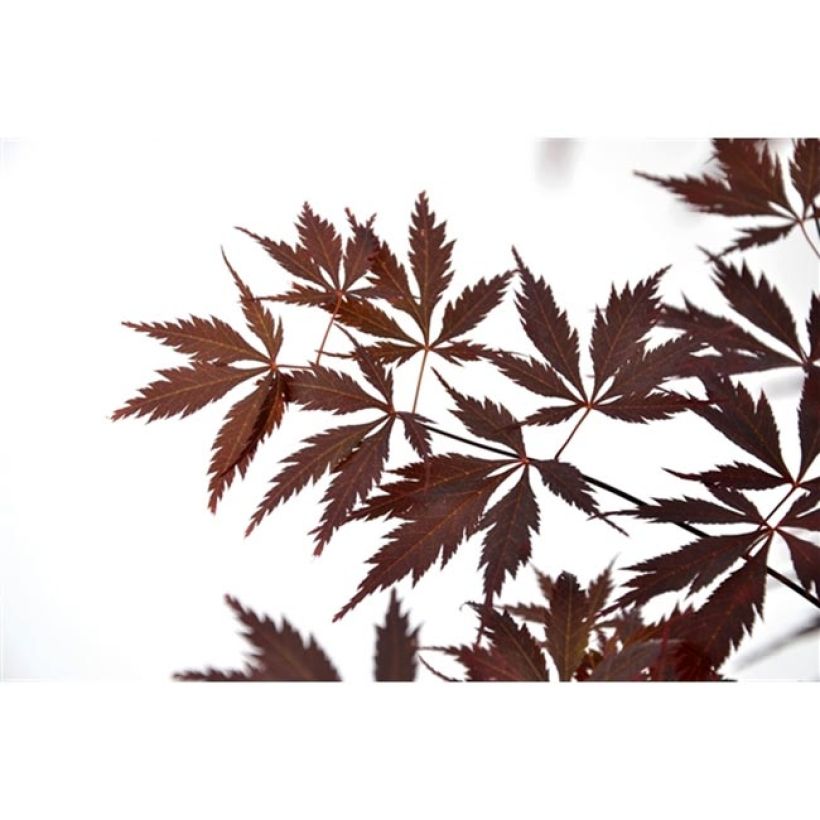

Acer palmatum Black Lace - Japanese Maple


Acer palmatum Black Lace - Japanese Maple
Acer palmatum Black Lace - Japanese Maple
Acer palmatum Black Lace
Japanese Maple, Palmate Maple
Beautiful maple
Raphael, 05/06/2023
Special offer!
Receive a €20 voucher for any order over €90 (excluding delivery costs, credit notes, and plastic-free options)!
1- Add your favorite plants to your cart.
2- Once you have reached €90, confirm your order (you can even choose the delivery date!).
3- As soon as your order is shipped, you will receive an email containing your voucher code, valid for 3 months (90 days).
Your voucher is unique and can only be used once, for any order with a minimum value of €20, excluding delivery costs.
Can be combined with other current offers, non-divisible and non-refundable.
Home or relay delivery (depending on size and destination)
Schedule delivery date,
and select date in basket
This plant carries a 24 months recovery warranty
More information
We guarantee the quality of our plants for a full growing cycle, and will replace at our expense any plant that fails to recover under normal climatic and planting conditions.


Would this plant suit my garden?
Set up your Plantfit profile →
Description
Acer palmatum 'Black Lace' is a new variety of Japanese maple with almost black foliage, finely divided and cut like lace! It forms a very graceful small tree with a spreading habit, suitable for small spaces and shady areas. In spring, the leaves are dark red. In summer, they darken to an almost black purple before quickly turning deep red before falling in autumn. It is a very hardy subject, ideal as a focal point in the middle of a small lawn or around a pond, in a container on a terrace, or to frame a flower bed in front of the entrance of the house.
Acer palmatum is native to eastern China, Korea, and Japan. It belongs to the Sapindaceae family. The 'Black Lace' cultivar is distinguished by lace-like foliage of almost black colour. It is a small, slow-growing, spreading tree that develops a thin and short trunk with dense and ramified branches. Eventually, it will reach a height of 3 m (9.8 ft) with a spread of about 3 m (9.8 ft), depending on growing conditions. Its deciduous foliage is composed of deeply divided palmate leaves with 7 distinct, narrow, lanceolate lobes, finely serrated and strongly toothed along the edges. The flowers, grouped in small clusters in April, are insignificant, but the fruits with curved wings are interesting from September onwards.
Acer palmatum 'Black Lace' is ideal as a focal point on a shaded lawn, or in ericaceous beds alongside azaleas, pieris, rhododendrons, hydrangeas, and heathers. It can also make a magnificent bonsai to be grown in a flat dish. Despite its delicate appearance, this small tree is robust, as evidenced by some specimens grown in large pots without much care for many years. It only requires light and well-drained soil, that is not too poor, and is preferably acidic to neutral. It requires occasional watering in dry weather. Diseases like Verticillium (caused by a fungus) are more likely to develop in constantly wet substrates than in occasionally dry ones. Note that this variety performs well in hot climates if the tree is planted away from the scorching sun and sheltered from the wind.
Report an error about the product description
Acer palmatum Black Lace - Japanese Maple in pictures




Plant habit
Flowering
Foliage
Botanical data
Acer
palmatum
Black Lace
Aceraceae
Japanese Maple, Palmate Maple
Cultivar or hybrid
Other Japanese Maples
View all →Planting and care
Plant in spring or autumn in a preferably acidic, cool but not wet, deep, loose and well-drained soil, in a partially shaded position, and sheltered from cold and dry winds. However, this Japanese Maple is one of the few that can tolerate dry air and adapts well to occasionally dry light soils in summer, especially in hot climates. The Verticillium disease, which affects many Japanese Maples, will develop less easily in substrates that dry out between waterings, which this variety tolerates very well. Apply a significant amount of organic matter every 3 years to ensure a good humus content in the soil. Mulch the soil if necessary and spray the foliage on hot evenings. Winter pruning is limited to balancing the branches. Treat against scale insects and Verticillium.
Planting period
Intended location
Care
-
, onOrder confirmed
Reply from on Promesse de fleurs
Similar products
Haven't found what you were looking for?
Hardiness is the lowest winter temperature a plant can endure without suffering serious damage or even dying. However, hardiness is affected by location (a sheltered area, such as a patio), protection (winter cover) and soil type (hardiness is improved by well-drained soil).

Photo Sharing Terms & Conditions
In order to encourage gardeners to interact and share their experiences, Promesse de fleurs offers various media enabling content to be uploaded onto its Site - in particular via the ‘Photo sharing’ module.
The User agrees to refrain from:
- Posting any content that is illegal, prejudicial, insulting, racist, inciteful to hatred, revisionist, contrary to public decency, that infringes on privacy or on the privacy rights of third parties, in particular the publicity rights of persons and goods, intellectual property rights, or the right to privacy.
- Submitting content on behalf of a third party;
- Impersonate the identity of a third party and/or publish any personal information about a third party;
In general, the User undertakes to refrain from any unethical behaviour.
All Content (in particular text, comments, files, images, photos, videos, creative works, etc.), which may be subject to property or intellectual property rights, image or other private rights, shall remain the property of the User, subject to the limited rights granted by the terms of the licence granted by Promesse de fleurs as stated below. Users are at liberty to publish or not to publish such Content on the Site, notably via the ‘Photo Sharing’ facility, and accept that this Content shall be made public and freely accessible, notably on the Internet.
Users further acknowledge, undertake to have ,and guarantee that they hold all necessary rights and permissions to publish such material on the Site, in particular with regard to the legislation in force pertaining to any privacy, property, intellectual property, image, or contractual rights, or rights of any other nature. By publishing such Content on the Site, Users acknowledge accepting full liability as publishers of the Content within the meaning of the law, and grant Promesse de fleurs, free of charge, an inclusive, worldwide licence for the said Content for the entire duration of its publication, including all reproduction, representation, up/downloading, displaying, performing, transmission, and storage rights.
Users also grant permission for their name to be linked to the Content and accept that this link may not always be made available.
By engaging in posting material, Users consent to their Content becoming automatically accessible on the Internet, in particular on other sites and/or blogs and/or web pages of the Promesse de fleurs site, including in particular social pages and the Promesse de fleurs catalogue.
Users may secure the removal of entrusted content free of charge by issuing a simple request via our contact form.
The flowering period indicated on our website applies to countries and regions located in USDA zone 8 (France, the United Kingdom, Ireland, the Netherlands, etc.)
It will vary according to where you live:
- In zones 9 to 10 (Italy, Spain, Greece, etc.), flowering will occur about 2 to 4 weeks earlier.
- In zones 6 to 7 (Germany, Poland, Slovenia, and lower mountainous regions), flowering will be delayed by 2 to 3 weeks.
- In zone 5 (Central Europe, Scandinavia), blooming will be delayed by 3 to 5 weeks.
In temperate climates, pruning of spring-flowering shrubs (forsythia, spireas, etc.) should be done just after flowering.
Pruning of summer-flowering shrubs (Indian Lilac, Perovskia, etc.) can be done in winter or spring.
In cold regions as well as with frost-sensitive plants, avoid pruning too early when severe frosts may still occur.
The planting period indicated on our website applies to countries and regions located in USDA zone 8 (France, United Kingdom, Ireland, Netherlands).
It will vary according to where you live:
- In Mediterranean zones (Marseille, Madrid, Milan, etc.), autumn and winter are the best planting periods.
- In continental zones (Strasbourg, Munich, Vienna, etc.), delay planting by 2 to 3 weeks in spring and bring it forward by 2 to 4 weeks in autumn.
- In mountainous regions (the Alps, Pyrenees, Carpathians, etc.), it is best to plant in late spring (May-June) or late summer (August-September).
The harvesting period indicated on our website applies to countries and regions in USDA zone 8 (France, England, Ireland, the Netherlands).
In colder areas (Scandinavia, Poland, Austria...) fruit and vegetable harvests are likely to be delayed by 3-4 weeks.
In warmer areas (Italy, Spain, Greece, etc.), harvesting will probably take place earlier, depending on weather conditions.
The sowing periods indicated on our website apply to countries and regions within USDA Zone 8 (France, UK, Ireland, Netherlands).
In colder areas (Scandinavia, Poland, Austria...), delay any outdoor sowing by 3-4 weeks, or sow under glass.
In warmer climes (Italy, Spain, Greece, etc.), bring outdoor sowing forward by a few weeks.


















































